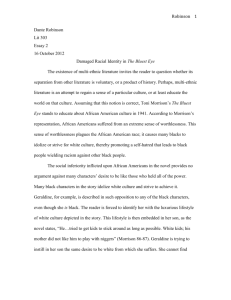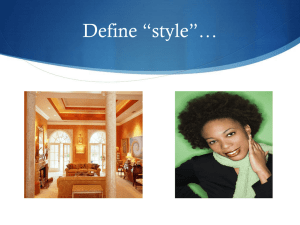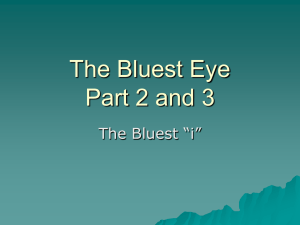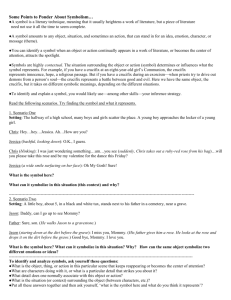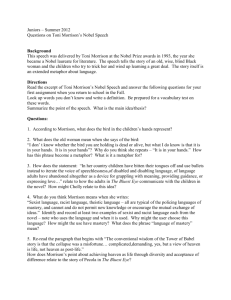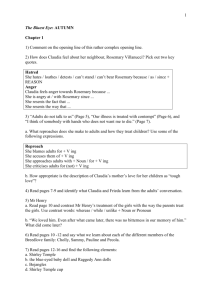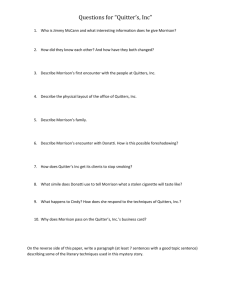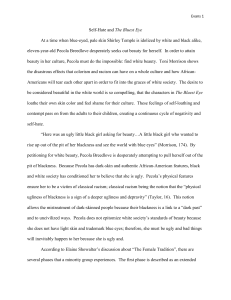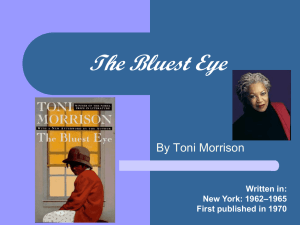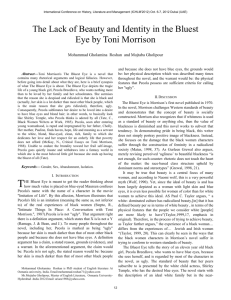The Hurt of Internalized Racism
advertisement
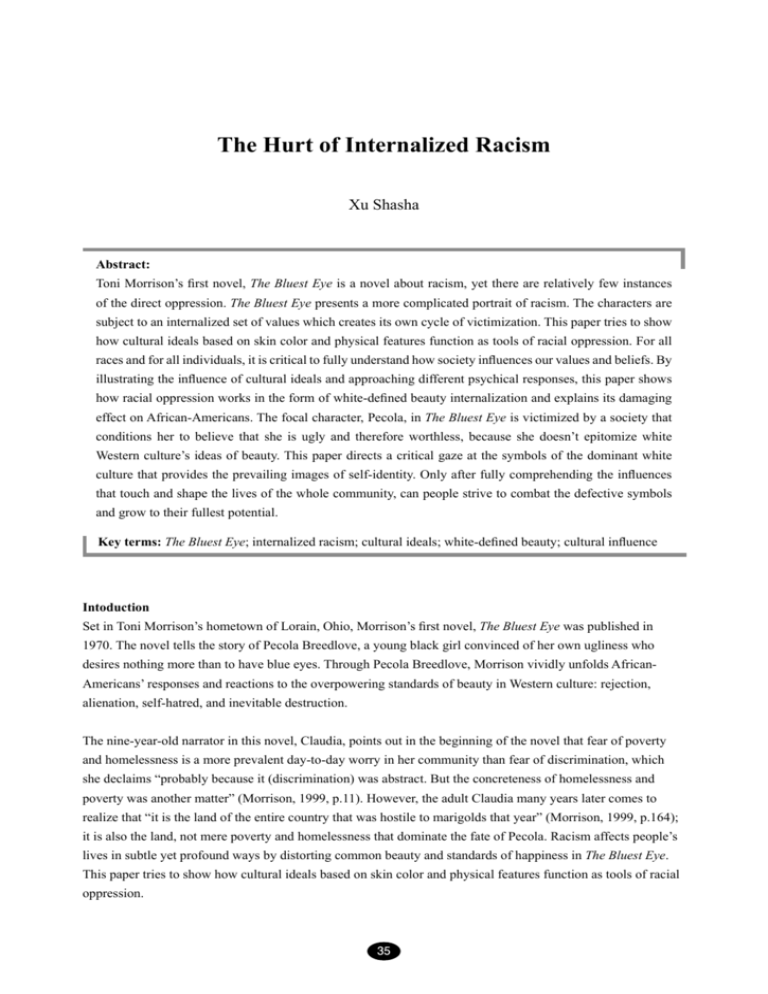
The Hurt of Internalized Racism The Hurt of Internalized Racism Xu Shasha Abstract: Toni Morrison’s first novel, The Bluest Eye is a novel about racism, yet there are relatively few instances of the direct oppression. The Bluest Eye presents a more complicated portrait of racism. The characters are subject to an internalized set of values which creates its own cycle of victimization. This paper tries to show how cultural ideals based on skin color and physical features function as tools of racial oppression. For all races and for all individuals, it is critical to fully understand how society influences our values and beliefs. By illustrating the influence of cultural ideals and approaching different psychical responses, this paper shows how racial oppression works in the form of white-defined beauty internalization and explains its damaging effect on African-Americans. The focal character, Pecola, in The Bluest Eye is victimized by a society that conditions her to believe that she is ugly and therefore worthless, because she doesn’t epitomize white Western culture’s ideas of beauty. This paper directs a critical gaze at the symbols of the dominant white culture that provides the prevailing images of self-identity. Only after fully comprehending the influences that touch and shape the lives of the whole community, can people strive to combat the defective symbols and grow to their fullest potential. Key terms: The Bluest Eye; internalized racism; cultural ideals; white-defined beauty; cultural influence Intoduction Set in Toni Morrison’s hometown of Lorain, Ohio, Morrison’s first novel, The Bluest Eye was published in 1970. The novel tells the story of Pecola Breedlove, a young black girl convinced of her own ugliness who desires nothing more than to have blue eyes. Through Pecola Breedlove, Morrison vividly unfolds AfricanAmericans’ responses and reactions to the overpowering standards of beauty in Western culture: rejection, alienation, self-hatred, and inevitable destruction. The nine-year-old narrator in this novel, Claudia, points out in the beginning of the novel that fear of poverty and homelessness is a more prevalent day-to-day worry in her community than fear of discrimination, which she declaims “probably because it (discrimination) was abstract. But the concreteness of homelessness and poverty was another matter” (Morrison, 1999, p.11). However, the adult Claudia many years later comes to realize that “it is the land of the entire country that was hostile to marigolds that year” (Morrison, 1999, p.164); it is also the land, not mere poverty and homelessness that dominate the fate of Pecola. Racism affects people’s lives in subtle yet profound ways by distorting common beauty and standards of happiness in The Bluest Eye. This paper tries to show how cultural ideals based on skin color and physical features function as tools of racial oppression. 35 Polyglossia Vol. 17, October 2009 Morrison’s allusion to the story of Dick and Jane In a sort of preface to the book, Morrison has written three versions of “Dick and Jane”, which was at that time nationally recognized as a children’s primary-reader story. Here is the house. It is green and white. It has a red door. It is very pretty. Here is the family. Mother, Father, Dick, and Jane live in the green-and-white house. They are very happy. Here is the house it is green and white it has a red door it is very pretty here is the family mother father dick and jane live in the green-and-white house they are very happy Hereisthehouseitisgreenandwhiteithasareddooritisveryprettyhereisthefamilymotherfatherdicka ndjaneliveinthegreenandwhitehousetheyareveryhappy. (Morrison, 1999, p.1-2) Morrison uses this to “juxtapose the fiction of the white educational process with the realities of life for many black children” (Klotman, 1979, p.123). The first version is clear, straight, rendered in standard English — correct and white. It represents the seemingly ideal, rich, white family (represented by the Fisher Family in the latter novel), which impinges upon the lives of the black children and their families while at the same time excluding them. The second version, while it repeats the message exactly, is less clear, yet still comprehensible although written without proper capitals or punctuation. The third, in which the letters completely run together, seems to signify nothing, yet it represents the home of Pecola, where her mother and her father curse and fight, her brother runs away and this black girl herself wishes with all her soul for blue eyes. Just as the Dick-and-Jane primer teaches children how to read, it also guides the children’s interpretation of the world. Pecola learns to recognize “what is beauty” and “I am ugly and miserable, or at least my family is” (Morrison, 1999, p.5) through the reading of the story of Dick and Jane, because home for her is not the green and white picture-perfect house of white myth. It is worth noticing that through this public education, the local culture is being oppressed and a seemingly innocent national ideal is being given the highest status. Influence of popular culture on the African-American community The public education has imposed a certain kind of image of a happy life on the children of a local culture. The novel then switches to the influence of popular culture on the African-American community, and an icon of the good, of the true, and of the beautiful— Shirley Temple— jumps out. Klotman (1979) comments that “whether one learns acceptability from the formal educational experience or from cultural symbols, the effect is the same: self-hatred” (p.124). Very early in the novel, Pecola shows excessive enthusiasm for Shirley Temple, which can be seen from her fascination with Frieda’s blue-and-white Shirley Temple mug and unstoppable milk-drinking from that mug — three quarts of milk a day. This can be interpreted as a part of her desire to internalize the values of white culture, a symbolic moment that foreshadows her desire to possess blue eyes. In yearning to be Shirley Temple, Pecola denies her own identity, “A little black girl yearns for the blue eyes of a little white girl, and the horror at the heart of her yearning is exceeded only by the evil of fulfillment” (Morrison, 1999, p.34). Pecola connects beauty with being loved and believes that if she possesses blue eyes, the cruelty in her life will be replaced by affection and respect. Surely, Pecola suffers most from white beauty standards and this hopeless desire leads ultimately to her madness. 36 The Hurt of Internalized Racism To Pecola, blue eyes, blond hair and white skin equals beauty, which leads to happiness. It is difficult to fault a young girl for this misinterpretation. Certainly both white and black communities in her world seem to support the idea. In The Bluest Eye, Morrison presents the whole community as having taken the white criteria of beauty for their own. Adult, older girls, shops, magazines, newspapers, windows’ signs— all the world had agreed that a blue-eyed, yellow-haired, pink-skinned doll was what every girl child treasured. (Morrison, 1999, p.14) Pecola is not alone in the internalization of the white-defined standard of female beauty. Transformation from rejection to worship of white culture Morrison provides a vivid insight into the psychical process in response to direct racial discrimination, by depicting the character of the smaller girl child Claudia. Not influenced by the white culture yet, little Claudia has not arrived at the turning point in the development of her psyche, which would allow her to love these “blue-eyed, yellow-haired, pink-skinned dolls”(Morrison, 1999, p.5). What Claudia feels at that time is “unconscious hatred, which ranges from white dolls to all the white girls” (Cheng, 2000, p.195).The black children start with a healthy, direct hatred of white superiority. However, when they get hurt as a result of that hatred (e.g. Claudia gets scolded after taking apart the doll) and receive the reinforcement of the message that whiteness is beautiful and blackness is ugly (e. g. the light-skin black girl Maureen’s popularity at school), they begin to look for refuge. “The best hiding place was love. Thus the conversion from pristine sadism to fabricated hatred, to fraudulent love.” (Morrison, 1999, p.16) The adult Claudia confesses that, I learn much later to worship Shirley Temple, just as I learn to delight in cleanliness, knowing, even as I learn, that the change is adjustment, without improvement. (Morrison, 1999, p.16) The adult Claudia diagnoses the black community’s worship of white images (as well as cleanliness and denial of the body’s desire) as a complicated kind of self-hatred, but they transform hatred into a false love to compensate. Popular culture can sometimes quicken this silent transformation, because the atmosphere it creates and racist messages are so prevalent that they are difficult to ignore. Therefore, African- Americans are especially vulnerable to the messages conveyed by popular culture that white beauty will inevitably dominate people’s life. Things never turn out that simple. If these cultural ideals, which function as tools of racial oppression, are only forced upon the African-Americans, Pecola would never turn to tragedy. It is not to say that external forces, such as racism and sexism, are unimportant, but “the ontological structures and mythological thought systems that blacks develop to define and reinforce their definitions of self and existence” (Samuels & Clenora, 1999, p.78) have a more harmful effect on them. In The Bluest Eye, Morrison points out sharply that African-Americans’ worship of white culture, along with their hopelessness, like Pecola’s ugliness, is a state of being that is both forced upon and chosen by them. This is why much criticism of Morrison’s works places her in an “integrated” literary tradition but does not identify her 37 Polyglossia Vol. 17, October 2009 with the tradition that has characterized much African-American literature, a tradition that “portrays racism as a definite evil” (Eichelberger, 1999, p.59). To Morrison, only when people choose and accept these white-defined values, do they begin to internalize them and view the world through the eyes of white culture. Before Pecola’s shopping experience to Mr. Yacobowski’s grocery store, there are some moments when Pecola temporarily succeeds in breaking the destructive connection between what she sees and how people see her. When she considers that dandelions are pretty (which are viewed as weeds by other people), she implicitly recognizes that beauty can be created by seeing rather than by being seen. By the same logic, she could redefine herself as beautiful even without blue eyes. However, Miner (1985) has noted that the “effect of popular American culture’s specular construction of beauty is that it bestows presence or absence” (p.93). One’s visibility depends upon one’s beauty, which is much worse than mere judgment of beautiful and ugly. Pecola’s shopping experience well serves as an outward reflection of the process of internalization of white values. When Pecola walks to the grocery store to buy candy, she encounters “the total absence of human recognition— the glazed separateness” (Morrison, 1999, p. 36). Mr. Yacobowski cannot acknowledge Pecola’s presence as a subject because he simply cannot look at her, “How can a fifty-two-year-old white immigrant storekeeper… see a little black girl?” (Morrison, 1999, p.36) These are only reinforcements of the influence of the white-beauty standard; Pecola’s response to Yacobowski, however, is of crucial importance. After she leaves the grocery store, she briefly experiences a healthy anger, but it gives way to shame. Morrison (1999) comments that “anger is better. There is a sense of being in anger. A reality and presence. An awareness of worth. It is a lovely surging” (p.37-38). But rather than continue this creative act, Pecola acquiesces and “the anger will not hold; it sleeps. The shame wells up again.” (Morrison, 1999, p. 38) Pecola interprets poor treatment and abuse as her own fault. She believes that the way people observe her is more reliable than what she herself observes. Then she considers dandelions are ugly. She takes solace in eating the candy, but, more importantly, in symbolically digesting the smiling picture of the blue-eyed, blond-haired little girl on the wrapper, She eats the candy, and its sweetness is good. To eat the candy is somehow to eat the eyes, eat Mary Jane. Love Mary Jane. Be Mary Jane. (Morrison, 1999, p. 38) In this process, Pecola chooses and internalizes within herself the values of white superiority values, thus consequently lives a life of self-hatred, and inevitable destruction. Another supportive example is from Pauline’ mother, Mrs. Pauline Breedlove. Pecola’s own mother reinforces the message the girls have been receiving about the superiority of whites. For Mrs. Pauline Breedlove, movies are the primary vehicle for transmitting white images for public consumption. She absorbs the set of values from the silver screen, then inflicts a severe wound on her husband and children who fail by “the scale of absolute beauty” (Matthews, 1997, p.188). Eventually, Pauline gives up on her own family and takes refuge in the soft beauty surrounding the Fishers’ home. When she speaks to Pecola and her friends, her voice is like “rotten pieces of apple, but when she speaks to the white girl, her voice is like honey” (Morrison, 1999, p.78). Her desire to deny her daughter is proved when the white girl asks who the black children are and Mrs. Breedlove avoids answering her. She has renounced her own black family for the family of her white employer. It is no longer the direct oppression of black by white, but oppression of a daughter by her 38 The Hurt of Internalized Racism mother who internalizes the white standard of beauty and uses it as a tool to hurt her own daughter. Conclusion For all races and for all individuals, it is essential to fully understand how mass culture touches, influences and shapes our values and beliefs — only after fully understanding that, can people strive to fight and grow to their fullest potential. Because of Morrison’s vivid portrait of the subtle yet profound cultural influence, the book won great success, though the plot of The Bluest Eye is not so fresh or different from those of other AfricanAmerican novels. Through her statement on the damage that internalized racism can do to the most vulnerable member of a community— a young girl, Morrison jumps out of the tradition of African-American literature that “portrays racism as a definite evil” (Eichelberger, 1999, p.59). By illustrating the influence of cultural ideals and approaching black people’s different psychical responses, this paper shows how racial oppression works in the form of white-defined beauty internalization and explains its damaging effect on African-Americans as well as on others within their families and the neighborhood. References Cheng, A. A. (2000). Wounded beauty: An exploratory paper on race, feminism, and the aesthetic question. Tulsa Studies in Women's Literature, 19(2), 191-217. Eichelberger, J. (1999). Prophets of recognition: Ideology and the individual in novels by Ralph Ellison, Toni Morrison, Saul Bellow, and Eudora Welty. USA: Louisiana State University Press. Klotman, R. P. (1979). Dick-and-Jane and the Shirley Temple sensibility in The bluest eye. Black American Literature Forum, 13(4), 123-125. Matthews, H. D. (1997). Response: The cultural aesthetic of blackness. Journal of the American Academy of Religion, 65(1), 187- 188. Miner, M. M . (1985). Lady no longer sings the blues: Rape, madness, and silence in The bluest eye. In P. Majorie & J. S. Hortense (Eds.), Conjuring: Black women, fiction, and literary tradition (pp. 91-176). Bloomington: Indiana UP. Morrison, T. (1999). The bluest eye. Great Britain: Vintage. Samuels, W. & Clenora, H. W. (1999). Twayne’s United States authors series online. New York: G. K. Hall & Co. 39
